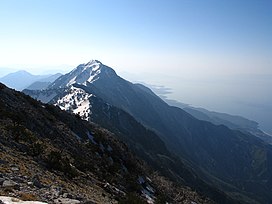Mount Çika
This article needs additional citations for verification. (December 2009) |
| Çika | |
|---|---|
| Maja i Çikës | |
 View of Mount Cika | |
| Highest point | |
| Elevation | 2,044 m (6,706 ft)[1] |
| Prominence | 1,563 m (5,128 ft)[2] |
| Listing | Ultra |
| Geography | |
Lua error in Module:Location_map at line 425: No value was provided for longitude.
| |
| Location | Vlorë County, Albania |
| Parent range | Ceraunian Mountains |
Mount Çika (Template:Lang-sq) is a mountain in the south-western region of Albania bordering the Ionian Sea. The highest peaks of Çika are Maja e Çikës, the highest peak of the Ceraunian Range, standing at 2,044m above sea level and Maja e Qorrës at 2,018m. Since the mountain is situated bordering the Ionian sea, it appears to be very high as it begins to rise at sea level(0m). The northern part of Çika is part of Llogara National Park. The port city of Vlorë is 40 km north-west of Çika. On the peaks of Çika mountain there is a magnificent view of the northern Ionian Islands as well as the Italian coast of Apulia (including Otranto). On the foot of the western side of the mountain there are small beaches which attract tourists during the summer months. These beaches include: Himarë, Palasa, Dhermi and Jala.
Llogara National Park
Llogara National Park lies between the Adriatic Sea and Ionian Sea. The park begins at 470 m above sea level and rises to 2,018 m at Maja e Qorrës which includes the northern part of Çika Mountain, forming Llogara Pass. Air currents at the Llogara Pass have caused trees to bend into many interesting shapes. For example Flag Pine, Pisha e Flamurit has the shape of the eagle on the Albanian flag. The stony surface of the Lightning Mountain, Vetëtima borders the park. The park has many opportunities for outdoor activities. The flora and fauna of Llogara National Park is very diverse consisting of both animals that live in the park's forests and mountain cliffs. Some of the best known animals include:
- Griffon vulture
- Golden eagle
- Fallow deer, tame
- Roe deer
- European wildcat
- Chamois
- Red squirrel
- Eurasian otter
- European badger
See also
References
- ^ Soviet military map К-34-136-А (1:50.000)
- ^ "Europe Ultra-Prominences". Peaklist.org. Retrieved 2013-07-05.
External links
